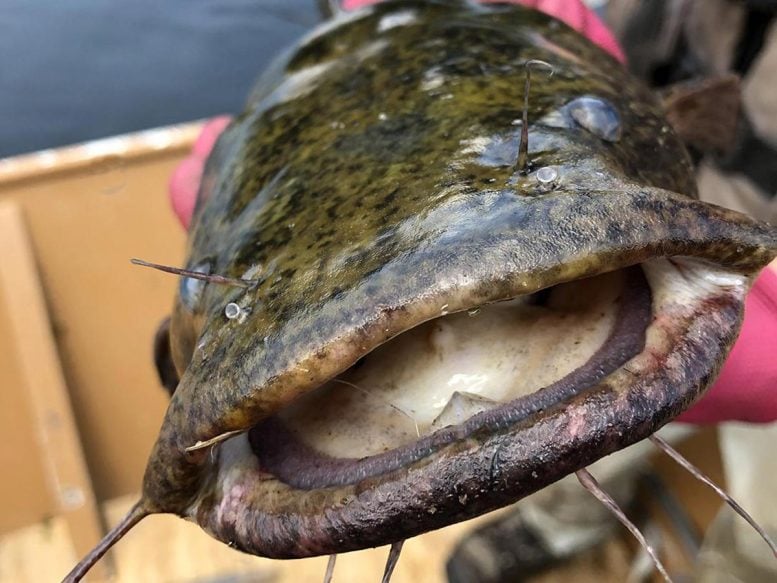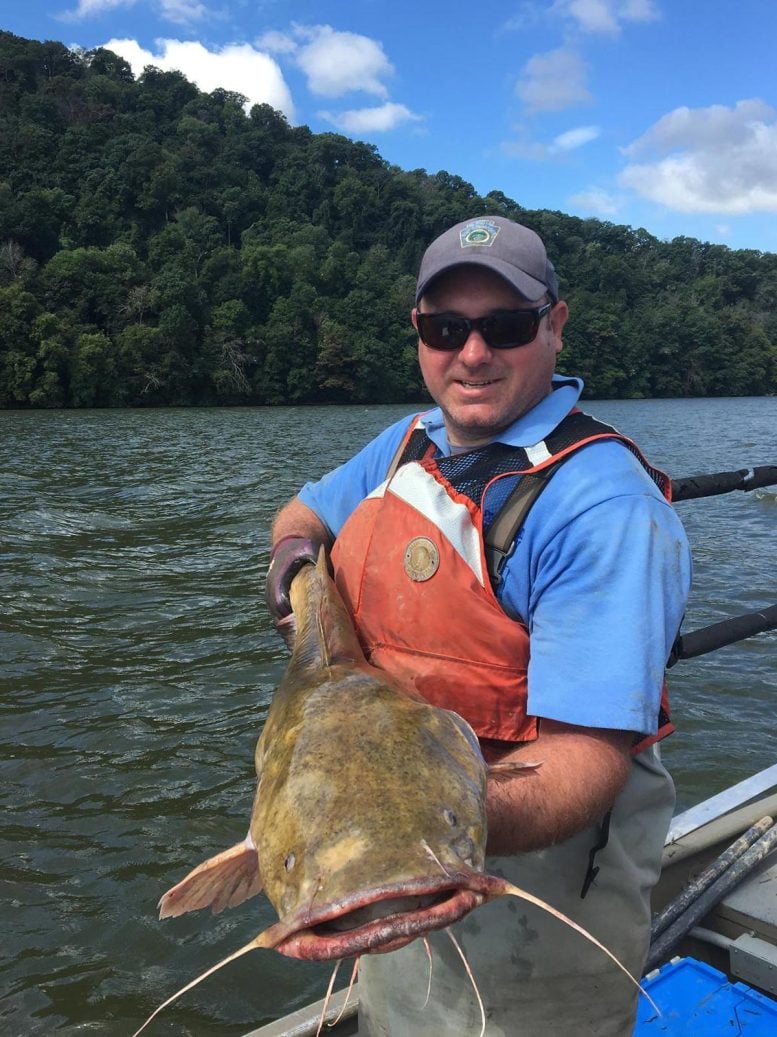
Flathead catfish, once native to the Mississippi River basin, have stealthily risen to the top of Pennsylvania’s Susquehanna River.
Growing fast, eating almost anything, and facing no real predators, they now dominate the food web. Researchers discovered that native fish like bass and channel catfish are shifting diets and behaviors just to survive, revealing how one invasive species can upend entire ecosystems.
Invasive Flathead Catfish on the Rise
Flathead catfish are powerful opportunistic predators originally from the Mississippi River basin. When introduced into new waterways or spreading from nearby river systems, they can severely damage native fish populations and recreational fisheries, disrupting entire ecosystems. Concern over these impacts prompted scientists from Penn State, the U.S. Geological Survey (USGS), and the Pennsylvania Fish and Boat Commission to investigate how flathead catfish are altering the food web and energy flow in Pennsylvania’s Susquehanna River. The species was first detected there in 1991, and its numbers have increased dramatically since then.
“Flatheads grow fast in this river system, attain large body sizes, and can eat a variety of prey,” explained study first author Olivia Hodgson, a master’s student in Penn State’s Intercollege Graduate Degree Program in Ecology. “Because adult flatheads have few natural predators, flathead catfish can exert strong control over the ecosystem.”
Hodgson worked with Tyler Wagner, a USGS scientist with the Pennsylvania Cooperative Fish and Wildlife Research Unit Program and an affiliate professor of fisheries ecology at Penn State. Wagner is the senior author of the study. Their findings, published September 4 in Ecology, confirmed that flathead catfish have become apex predators in the river.

Outcompeting Native Predators
The researchers found that flatheads hold the highest trophic position (the place an organism occupies in a food web based on what it eats and what eats it). Their position ranked above long-standing top predators like smallmouth bass and channel catfish. In areas where flatheads are present, channel catfish dropped to lower levels of the food chain, likely either because they are being displaced by the newcomers or deliberately avoiding them. In those same sections of the river, all species examined showed wider, overlapping diets.
“This suggests that resident species are changing what they eat to avoid competing with or being eaten by the invader,” Hodgson said. “These findings support the ‘trophic disruption hypothesis,’ that says when a new predator enters an ecosystem, it forces existing species to alter their behavior, diets, and roles in the food web. This can destabilize ecosystems over time. Our study highlights how an invasive species can do more than just reduce native populations — it can reshape entire food webs and change how energy moves through ecosystems.”
Studying Food Web Disruption
Although the predatory effects of invasive catfishes on native fish communities have been documented — such as in a recent study on the Susquehanna River led by researchers at Penn State — the impacts of invasion on riverine food webs are poorly understood, Hodgson noted. This study quantified the effects of invasive flathead catfish on the food web in the Susquehanna by comparing uninvaded river sections to invaded sections, focusing on several key species: flathead catfish — invader, channel catfish and smallmouth bass — resident predators, and crayfish and minnows — prey.
In addition to evaluating trophic position, the researchers analyzed the isotopic niche occupied by the fish species — the range of carbon and nitrogen markers found within the tissues of an organism, reflecting its diet and habitat, providing insights into its ecological role.

To reach their conclusions, the researchers employed stable isotope analysis, a widely used tool that can explain patterns within a food web, highlighting links between trophic positions, as well as the breadth and overlap of trophic niches. Stable isotope analysis is especially useful for studying invasion ecology, such as investigating trophic reorganization and trophic overlap between introduced and resident species.
When fish eat, their bodies incorporate the isotopic signature of their food. By sampling their tissues, scientists can measure nitrogen isotopes and determine their diet, carbon isotopes to determine habitat use, and compare isotopic signatures across regions to deduce fish migration or habitat shifts. For this study, channel catfish, smallmouth bass, minnows, and crayfish were selected as focal species because a previous diet analysis conducted in collaboration with Penn State, USGS, and Pennsylvania Fish and Boat Commission researchers within the Susquehanna River showed that these species are important prey for flathead catfish.
Collecting and Processing Samples
The researchers collected a total of 279 fish and 64 crayfish for stable isotope analysis, including 79 flathead catfish, 45 smallmouth bass, 113 channel catfish, and 42 minnows comprising nine species. All samples were oven dried and ground to a fine powder using a mortar and pestle. Stable isotope samples were sent to Penn State’s Core Facilities and the Michigan State University Stable Isotope Laboratories for isotope determination.
“Stable isotope analysis explained patterns within the Susquehanna food web in habitats invaded and not invaded by the flathead catfish, and it allowed us to understand links between different species in the river food web and how invasive species might lead to changes in how native species interact and compete, what they eat and how their diets overlap, and if they might be displaced from preferred habitats by the invader,” Hodgson said. “We were able to infer resource use, helping us to better understand potential competition for resources and how this changes when flathead catfish become established.”
Reference: “Invasive predatory fish occupies highest trophic position leading to expansion of isotopic niches in a riverine food web” by Olivia C. Hodgson, Sydney Stark, Megan K. Schall, Geoffrey D. Smith, Kelly L. Smalling and Tyler Wagner, 4 September 2025, Ecology.
DOI: 10.1002/ecy.70180
Contributing to the research were: Sydney Stark, recent Penn State graduate with a master’s degree in wildlife and fisheries science; Megan Schall, associate professor of biology and science at Penn State Hazleton; Geoffrey Smith, Susquehanna River biologist for the Pennsylvania Fish and Boat Commission; and Kelly Smalling, research hydrologist with the U.S. Geological Survey, New Jersey Water Science Center.
Funding for this research was provided by Pennsylvania Sea Grant and the U.S. Geological Survey.
Never miss a breakthrough: Join the SciTechDaily newsletter.
1 Comment
Are they edible?